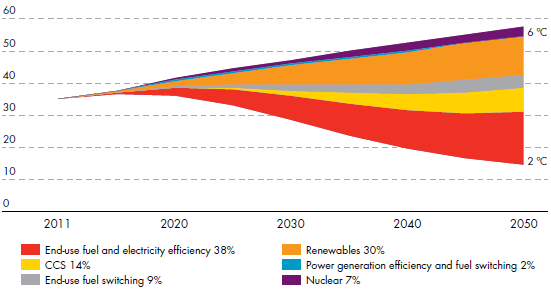1 MILLIONTonnes of CO2 each year is expected to be captured by the Quest CCS project in Alberta, Canada
2/3Shell estimated rise in energy demand from today’s level by 2060
66%Of the world’s population could be living in cities by 2050
Today’s global energy system is under pressure from the need to tackle climate change. There is an urgent need to reduce global carbon dioxide (CO2) emissions. In 2014, a report by the Intergovernmental Panel on Climate Change (IPCC) stated that the “warming of the climate system is unequivocal and unprecedented, with emissions rising faster than ever before.” The IPCC has called for a global ambition to reach net-zero CO2 emissions by 2100.
At the same time, energy demand is increasing. In some countries, energy access can mean the difference between prosperity and poverty, and sickness and health. By 2060, Shell estimates that energy demand could rise by two-thirds from its level today, with much of the growth coming from emerging economies.
More energy, less CO2
As the world reassesses the way in which it produces and consumes energy, the challenge is how to provide more energy with less CO2 and to move from a predominantly carbon-based system towards one of net-zero carbon emissions. Our Shell New Lens Scenarios (see disclaimer), published in 2013, show that net-zero annual energy system emissions is achievable by 2100. The scenarios analyse current economic trends and projects plausible pathways into the future.
The role of renewables
Renewable energy – including wind, solar, biomass and hydropower – will play a key role in the transition towards a lower-carbon future. It will eventually become the largest component of the global energy system. Our scenarios show that by 2060 renewables could supply at least four times more energy than they contribute today.
In advanced economies there is already an increase in renewables and natural gas as sources of power generation.
The role of hydrocarbons
Despite this strong rise in renewables, a mix of energy sources will be needed to meet growing global demand. It is possible to have an energy mix that includes oil and gas, along with biofuels and solar and wind power, as part of the transition to a lower-carbon future. Hydrocarbons will be part of this energy transition. The key is to reduce the associated emissions with carbon capture and storage (CCS), energy efficiency and a shift from coal to gas.
If we are to maintain a continuous supply of energy, there will need to be ways to support the shortcomings of renewables, such as their intermittency in producing power and the high cost of investment currently required.
Achieving a 2 °C scenarioGt CO2 sectors and technologies

Source: International Energy Agency (2014), Energy Technology Perspectives 2014, OECD/IEA, Paris
Achieving a 2 °C scenario
To limit the global average temperature increase to 2 °C the deployment of a range of technologies will be required: energy efficiency; fuel switching; renewables; nuclear; and CCS.
The graph from the International Energy Agency (IEA) shows the current projections if there is no reduction in CO2 emissions, leading to a 6 °C global temperature rise. It also shows the potential contribution of the most relevant technology options for an 80% chance to reduce emissions to achieve the globally agreed limit of 2 °C. (See “Energy and climate change”).
IEA analysis offers strong evidence that the role of CCS will be significant, with a cumulative contribution of 14% up to 2050.




